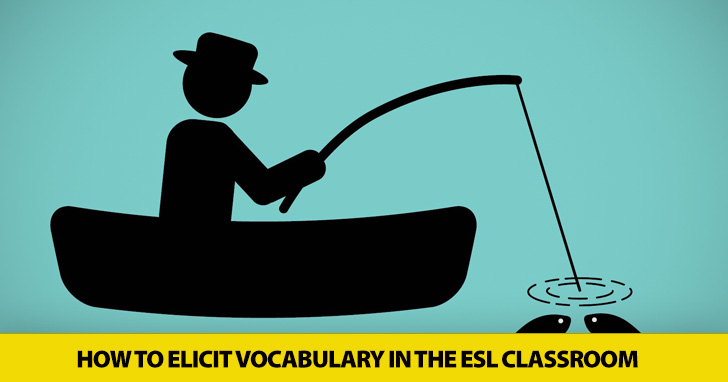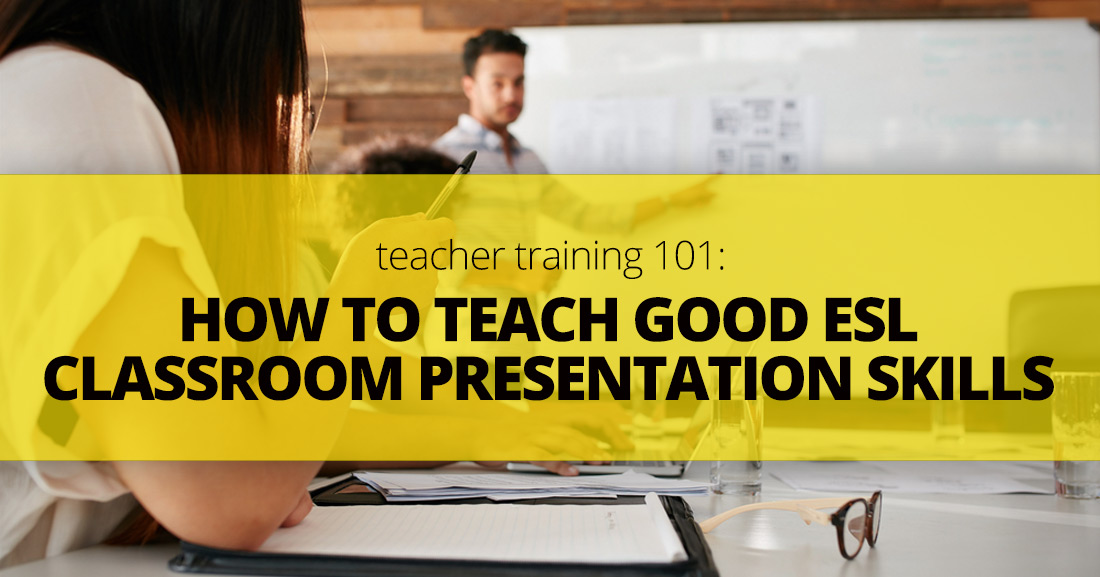Ask, Donít Tell: How to Elicit Vocabulary in the ESL Classroom


I’m going to give you four words, and your task is to figure out how to communicate their meaning to a space alien who speaks only fifty words of English. You can use English, drawings, your hands and facial expression, and any objects normally found in a classroom. Ready?
Telescope (n) Chef (n) Take-Off (v, aircraft) Bored (adj)
How you tackle this exercise might be quite revealing. How much speaking did you do? Did you use your hands, all the way through the explanation? What was your facial expression doing? How many words were necessary to get the meaning across, and what kinds of words were they? Do you think the space alien would have understood the words, or were gestures and pictures essential? A little later, we’ll see how experienced teachers reacted to this same challenge.
***
When training teachers to communicate new meanings to their students, especially to near-beginners, try to consider the presentation from the students’ point of view. This requires a certain empathy; it’s always helped me to imagine someone teaching me in my L2 (second language), or even my L3 or L4 (French, German and Mandarin, respectively). How much of it would I truly comprehend? Alongside a spoken explanation, what could the teacher do to help me understand?
ESL has come a long way since the days of rote-learning and translation, and we now have the opportunity to develop skills which provide for a much more interactive model of presentation.
Well, the teacher can do a great deal. ESL has come a long way since the days of rote-learning and translation, and we now have the opportunity to develop skills which provide for a much more interactive model of presentation. Instead of telling, we show; instead of expecting comprehension, we invite it; and instead of giving the meaning, we elicit.
New teachers often struggle with those first attempts to communicate a new word or structure; there’s a terrible sinking feeling known only to teachers whose careful explanation has yielded only a room full of blank faces. Here are some tips for preventing these experiences from denting your trainees’ confidence, and for building the vital presentation skills which will see them through a whole career in ESL.
I’ve been using an analogy with my trainees: If you were learning how to play tennis, you wouldn’t only practice your volleys and returns; you’d also want to perfect your serve. It’s an interactive game, involving two people. Well, ESL presentation is a little like tennis; we’re serving vocabulary and structures at our students, but we want them to volley back their replies, showing us that they’ve understood what’s going on. As a tennis novice will tell you, this is made much easier if things are kept nice and slow, and if the instructor doesn’t send over too many unexpected shots.
This might sound counter-intuitive, but one of the best ways to tell someone a new piece of information is actually to ask them about it.
This might sound counter-intuitive, but one of the best ways to tell someone a new piece of information is actually to ask them about it. The chances are that they already know some of the surrounding detail; this is called eliciting, and it’s a cornerstone technique of modern ESL. Even when teaching a new structure, we can ask questions as we go. This ensures the students are engaged, frequently checks their understanding, and provides for a more enjoyable, interactive classroom atmosphere. Here’s an example from my intermediate class in Boston, just after we’d finished a short reading passage:
| Teacher: | OK, so it says that Jose was given a ‘temporary license’. Hmm, what could ‘temporary’ mean? |
| Students: | (Thinking) |
| Teacher: | Is it the same as ‘forever’? |
| Students: | No. |
| Teacher: | Good. So, how long could it be for? |
| Student 1: | Days? |
| Teacher: | Yeah, or maybe a little longer? |
| Student 2: | Weeks? Maybe month? |
| Teacher: | Excellent. Try that with me, guys: temporary |
| Students: | Temporary (chorus drill, followed by individual pronunciation drill) |
| Teacher: | Awesome. What else is temporary, gang? What about your visa? Is that temporary or permanent? |
| Students: | Temporary! / Is not forever |
| Teacher: | I agree! What about the weather? |
| Students: | Temporary / That’s temporary, too / Is changing all the time. |
My teacher-trainees find this kind of exchange rather remarkable. I didn’t need to explain the word, as such, because we encountered it in a useful context. Then, I spent the rest of the ‘explanation’ simply asking questions which helped confirm the meaning. Best of all, the students said the word multiple times, eventually using it in a sentence. Not every word can be communicated this way, but this example provides a really good model:
Many teachers talk far too much in class; we’re all guilty of this, from time to time. Mostly, I’ve found, it’s the newbies who chatter away at length, and in some situations, this is just fine (e.g. a lecture or presentation) but for ESL learners, this can be confusing, distracting, demoralizing and, perhaps worst of all, dull.
I give my trainees a rule, and it’s one which I apply to myself in pretty much every teaching circumstance:
Never speak for longer than twenty seconds without asking a question which requires a thoughtful answer.
(And by a ‘thoughtful answer’, I discount the results of binary (yes/no) questions.)
This rule is tough to stick to, but when properly applied, it’s one good route into the most fruitful language-learning territory: an open, truly interactive classroom environment where spontaneous production is expected, and where everyone may contribute equally.
Return to the little experiment we started with. How many words did you need to explain ‘telescope’? Which of these explanations is closest to your own?
My favorite is actually ‘B’, because it uses only two potentially new words (‘mirror’ and ‘planet’). ‘A’ and ‘C’ use too many unfamiliar words (if our students are learning ‘telescope’ for the first time, they probably won’t know ‘scientific’, ‘instrument’, ‘heavens’, ‘magnifying’, or ‘astronomy’). This reminds us of another good maxim for presentation: Never use a new word to teach a new word.
Have your students boil down their explanations until they’re as concise and simple as possible. And then have them record the explanation and judge the speed of their speaking. Invite them to stand outside of their native-level language experience, and consider the impact of these explanations, and this speed of speaking, on their students. This kind of empathy gets easier with practice.
Gestures cut down TTT and add an important visual element. Did you use a gesture, for example, when teaching ‘take-off’ or ‘bored’? Modern ESL depends on using your hands, and those of experienced teachers are always in motion. If they’re not helping to explain something, they’re engaged in classroom management, choosing the next student to answer, or organizing pairwork. A video recording will reveal how gestural your trainees are; basically, if their hands are by their sides for long periods, they’re probably missing a communications opportunity.
Some of the most valuable sections of my own CELTA training were those twenty-minute practice sessions with a whiteboard and a pen. Writing on a vertical wall takes getting used to, and if you’re not an artist (and, believe me, I’m not!) then practicing basic stick-figure drawings can add a really useful visual tool to your explanatory arsenal.
A picture tells a thousand words – or at least, it can radically cut down on TTT, and we’re always looking for new ways to do that. Get them ready in advance, so you’re not leafing through the book or magazine, or worse, browsing around the Internet while your students gradually lose interest. Bookmark the site, or have the picture ready in another browser tab or window.
When practicing reading with your students, it can be hard to figure out which words to highlight, and which to assume that they know. Experience will help, as will a syllabus or word list, but look closely at the text and use what you already know about yours students. Which words are most likely to trip them up? Which could you check quickly, and which will need actually explaining?
Have your trainees make a list of these target words before you start, beginning with the tough ones, and prepare concise (preferably multi-media) explanations.
Watching a video of yourself teaching is a truly strange experience, but it teaches us more about our style, approach, speed of speaking, timings and body language than any assessment by an observer. I encourage my trainees to bite the bullet and record all of their initial classes, and then use the recordings to drive down their TTT, tighten up their explanations, and help brainstorm new and better explanatory methods.
My trainees understandably freak out a little when faced with these challenges. “How can I communicate with people who don’t speak any English?” is the common question. I remind them that communication need not be elaborate, and it certainly need not all rely on spoken language. If you’re well prepared and you’ve thought in advance about the target language and structures, all you need is a board, a pen, your hands, and a sense of humor. Trainees quickly find that they can boil down their explanations to an irreducible simplicity, use different media to engagingly explain the meanings, and tailor their spoken language to suit the level of their students.
Finally, I promised some methods of explaining the words in our experiment, back at the beginning. Here are my favorites:
Telescope: “For looking at the (night) sky”. Gesture a long tube, placed to your eye, and pretend to point it out of the window. Show a picture of Galileo’s telescope, then a large observatory or the Hubble Space Telescope. Finish with some pictures from the HST, because they’re always gorgeous and engaging. Check questions: Binary (“Have you ever looked through a telescope?”) and open (“What can telescopes see?”) Elicit related vocabulary: planets, the moon, galaxies, stars, astronomer.
Chef: “Makes wonderful, expensive food”. Show pictures of a famous chef in his white apron and hat. Check questions: Binary (“Does a chef work in a fast food restaurant?”) and open (“What kind of food does a chef make?” and “How many Michelin stars does a great chef have?”) Elicit related vocabulary: Kitchen, restaurant, quality, reservation, famous.
Take-Off: “When a plane leaves (on its journey / from the airport)”. Gestures might be enough: a flattened hand accelerates across the desk and then swoops into the air. Pictures will help, or a video. Check questions: binary (“Is the plane arriving?”) and open (“How fast does the plane go at take-off?” and “How does take-off feel for the passengers?”) Elicit related vocabulary: Speed, airport, airline, landing, passengers, noise, vibration.
Bored: “When there is nothing interesting.” Gestures will play a big role; slumped in your seat, looking listless, maybe glancing at your watch, sighing, looking around for something to do. Check questions: Binary (“Is ___ boring?” (e.g. chess, a long plane ride, bungee-jumping, etc)) and open (“What do you find boring?” or “Which class is the most boring?” Elicit related vocabulary: Tired, sleepy, dull, engage, interest.